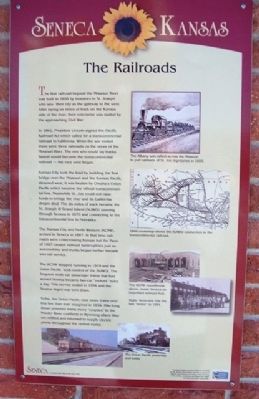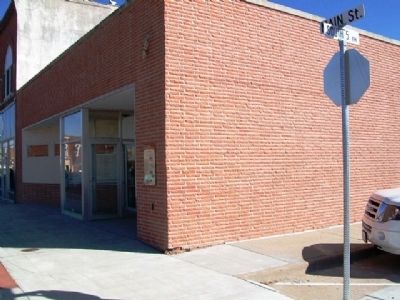Seneca in Nemaha County, Kansas — The American Midwest (Upper Plains)
The Railroads
The first railroad beyond the Missouri River was built in 1859 by investors in St. Joseph who saw their city as the gateway to the west. After laying six miles of track on the Kansas side of the river, their enterprise was stalled by the approaching Civil War.
In 1862, President Lincoln signed the Pacific Railroad Act which called for a transcontinental railroad to California. When the war ended, there were three railroads on the shore of the Missouri River. The one who could lay tracks fastest would become the transcontinental railroad - the race west began.
Kansas City took the lead by building the first bridge over the Missouri and the Kansas Pacific steamed west; it was beaten by Omaha's Union Pacific which became the official transcontinental line. Meanwhile St. Joe could not raise funds to bridge the river and its California dream died. The six miles of track became the St. Joseph & Grand Island (StJ&GI) passing through Seneca in 1870 and connecting to the transcontinental line in Nebraska.
The Kansas City and North Western (KCNW), arrived in Seneca in 1887. At that time railroads were crisscrossing Kansas but the Panic of 1893 caused railroad bankruptcies just as automobiles and trucks began further inroads into rail service.
The KCNW stopped running in 1919 and the Union Pacific took control of the StJ&GI. The frequent multi-car passenger trains that had served Seneca became two car "motors" twice a day. This service ended in 1954 and the Seneca depot was torn down.
Today, the Union Pacific runs more trains over this line than ever imagined in 1859. Mile-long diesel powered trains move "empties" to the Powder River coalfields in Wyoming where they are refilled and returned to supply electric plants throughout the central states.
Erected by City of Seneca and Kansas Humanities Council.
Topics and series. This historical marker is listed in these topic lists: Railroads & Streetcars • Settlements & Settlers. In addition, it is included in the Former U.S. Presidents: #16 Abraham Lincoln series list. A significant historical year for this entry is 1859.
Location. 39° 50.048′ N, 96° 3.754′ W. Marker is in Seneca, Kansas, in Nemaha County. Marker is at the intersection of Main Street and 5th Street, on the left when traveling west on Main Street. Touch for map. Marker is in this post office area: Seneca KS 66538, United States of America. Touch for directions.
Other nearby markers. At least 8 other markers are within walking distance of this marker. The First National Bank (within shouting distance of this marker); The Buggy Store (within shouting distance of this marker); The Smith Hotel (about 300 feet away, measured in a direct line); Pony Express Home Station (about 300 feet away); City Hall (about 300 feet away); The Felt Block (about 400 feet away); The Seneca Free Library (about 600 feet away); The Seneca Post Office (about 600 feet away). Touch for a list and map of all markers in Seneca.
Also see . . .
1. Railroads in Kansas. (Submitted on March 17, 2013, by William Fischer, Jr. of Scranton, Pennsylvania.)
2. Union Pacific Railway. (Submitted on March 17, 2013, by William Fischer, Jr. of Scranton, Pennsylvania.)
3. St. Joseph & Grand Island Railway. (Submitted on March 17, 2013, by William Fischer, Jr. of Scranton, Pennsylvania.)
Credits. This page was last revised on September 8, 2020. It was originally submitted on March 17, 2013, by William Fischer, Jr. of Scranton, Pennsylvania. This page has been viewed 413 times since then and 24 times this year. Photos: 1, 2. submitted on March 17, 2013, by William Fischer, Jr. of Scranton, Pennsylvania.

